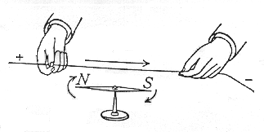Repeat Oersted's Experiment !
Note: This experiment can also be performed on top of a projector in the classroom, for the entire class to watch. See Teaching about Magnetism.
You will need:
- A pocket compass.
- A one-foot (30 cm) length of fairly thick wire, insulated or bare.
- A 1.5 volt electric cell ("battery") of size "D" or "C". The voltage is too low to cause any risk.
- Lay the compass on a table, face upwards. Wait until it points north.
- Lay the middle of the wire above the compass needle, also in the north-south direction (compare to the above image "What Oersted Saw"). Bend the ends of the wire so that they are close to each other.
- Grab one end of the wire in one hand and press against one end of the battery.
- Grab the other end with your other hand, and press momentarily against the other terminal of the battery. The needle will swing strongly by 90 degrees.
Quickly disconnect (it is not good for the battery to draw such a large current). The needle will swing back to the north-south direction. Note that no iron is involved in producing the magnetic effect!
- Repeat with the connections of the battery reversed. Note that the needle now swings 90 degrees in the opposite direction.
- Take a piece of paper 2"x4" (5x10 centimeters) and fold the longer side into pleats, about 3/8" (1 centimeter) high. Put the wire on the table, its middle in the north south direction, put the pleated paper above it so that the wire is below one of the pleats, and place the compass on top of the pleats. (Or else, use a small block of wood, with a groove cut in its bottom for the wire.)
You can now repeat the experiment with the compass above the wire (if two people perform the experiment, they need no pleats or table--one can old the compass, the other the wire and battery). Note that the needle swings in the opposite direction than when the compass was below the wire.
Questions from Users:
*** On building an electromagnet
Futher reading:
--look up in an encyclopaedia "Halley, Edmond", "Oersted, Hans Christian", "Ampere, Andre-Marie" and "Maxwell, James Clerk."
--"From Falling Bodies to Radio Waves" by Emilio Segre, W.H. Freeman and Co., 1984, gives a very good account of the history of electricity and magnetism (and of physics up to 1895). Segre, who won the Nobel prize in physics, wrote in a clear style with many insights and anecdotes about the discoveries which laid the foundations of physics.
--"Oersted and the Discovery of Electromagnetism" by Bern Dibner (Blaisdell Publ. Co., 1962), a slim book with details about Oersted and his time.
--"Andre-Marie Ampere" by L.Pearce Williams, Scientific American January 1989, p. 90.
--"Edmond Halley, Geophysicist" by Michael E. Evans, Physics Today, February 1988, p. 41-45.
|
 Edmond Halley
Edmond Halley
 Oersted's Experiment
Oersted's Experiment What Oersted saw...
What Oersted saw... Maxwell
Maxwell